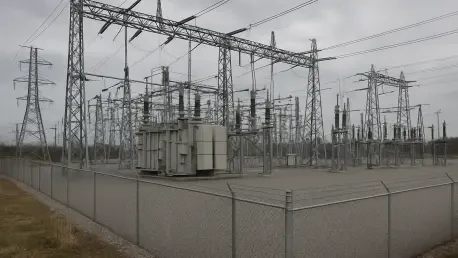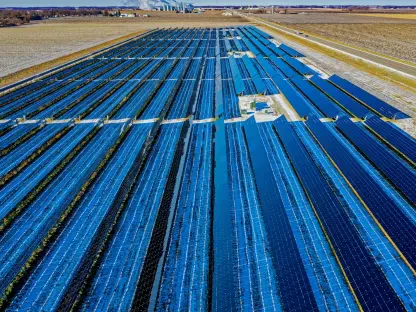In the sprawling landscape of Texas, Oncor Electric Delivery finds itself at the epicenter of an extraordinary energy challenge, grappling with an unprecedented interconnection queue of 200 gigawatts (GW). This staggering demand, largely propelled by the explosive growth of data centers, underscores the state’s emergence as a powerhouse for energy-intensive industries driven by artificial intelligence (AI), cryptocurrency mining, and traditional industrial expansion. As one of the largest electric utilities in Texas, Oncor is tasked with meeting the needs of a digital era while ensuring grid stability for millions. The scale of this surge signals not just a local phenomenon but a broader shift in how energy infrastructure must adapt to technological revolutions. With pressure mounting to integrate massive new loads, Oncor’s strategies and its parent company Sempra’s financial maneuvers offer a glimpse into the future of energy delivery in a rapidly evolving landscape.
Unpacking the Demand Explosion
Dissecting the Massive Queue
The sheer magnitude of Oncor’s 200 GW interconnection queue reveals a transformative moment for Texas’s energy sector, with data centers accounting for an overwhelming 186 GW of the total demand. This dominant share highlights the critical role of digital infrastructure in driving electricity needs, as businesses rush to support AI and cloud computing. Alongside this, traditional sectors contribute significantly, with 7 GW from commercial and industrial customers, 5 GW tied to cryptocurrency mining operations, and 4 GW from oil and gas activities. According to Oncor CEO Allen Nye, approximately 20% of this potential load—around 40 GW—is either under signed contracts or classified as high-confidence, suggesting a strong likelihood that these projects will materialize. This breakdown illustrates not only the diversity of demand but also the urgency for Oncor to prioritize and plan for a future where digital and industrial growth converge on an unprecedented scale.
Beyond the numbers, the composition of this queue reflects Texas’s unique position as a magnet for high-energy industries, positioning Oncor as a key player in shaping the state’s economic trajectory. The dominance of data centers points to a long-term trend where technology will increasingly dictate energy planning, while the presence of crypto mining and oil and gas loads underscores the state’s diverse industrial base. Oncor must navigate this complex mix while anticipating which segments will grow fastest, ensuring that infrastructure investments align with actual demand. The high-confidence load figure provides some clarity, yet the remaining 80% of the queue introduces uncertainty, requiring flexible strategies to adapt to shifting priorities. This balancing act between confirmed projects and speculative requests is central to Oncor’s challenge, as missteps could strain resources or delay critical connections for industries fueling Texas’s boom.
Implications for Grid Planning
The enormity of Oncor’s interconnection queue demands a rethinking of grid planning, as the utility faces the task of integrating massive new loads without compromising reliability. With 1,100 new large-load customers in the pipeline and 9 GW already under signed agreements, the pressure to expand capacity is immense. Oncor’s recent addition of service to 20,000 new properties in a single quarter further illustrates the rapid pace of growth it must accommodate. This surge necessitates not only physical infrastructure upgrades but also sophisticated forecasting to predict where and when demand will spike. Failure to align expansion with actual needs could lead to inefficiencies or outages, undermining confidence in the grid. Oncor’s ability to anticipate and respond to these dynamics will be crucial in maintaining its role as a backbone of Texas’s energy system.
Moreover, the operational challenges extend beyond simply building new lines or substations; they involve ensuring equitable access for both emerging industries and existing customers. Data centers, with their outsized energy needs, could potentially monopolize resources if not carefully managed, leaving smaller commercial or residential users at a disadvantage. Oncor must develop policies and frameworks to prioritize connections fairly while adhering to regulatory mandates. The integration of such diverse loads also raises questions about grid resilience, particularly in a state prone to extreme weather events. Strengthening the system to handle both routine demand and unexpected stressors will require innovative engineering solutions and robust planning, ensuring that growth does not come at the expense of stability. This multifaceted approach is essential for Oncor to succeed in this high-stakes environment.
Strategic Responses and Industry Shifts
Financial Backing for Infrastructure Growth
To tackle the colossal demand represented by the 200 GW queue, Oncor’s parent company, Sempra, is orchestrating a bold financial strategy to fund necessary infrastructure upgrades. A potential increase of over $12 billion to Oncor’s existing $36 billion capital plan is under consideration, reflecting the scale of investment required to meet Texas’s energy needs. To secure this funding, Sempra is pursuing strategic divestitures, including the sale of its Ecogas Mexico business and a 15% to 30% equity stake in Sempra Infrastructure to a global investment firm, with transactions expected to close by mid-2026. These moves aim to bolster Sempra’s balance sheet, providing the capital needed to support Oncor’s ambitious expansion. This financial maneuvering demonstrates a proactive approach to addressing the infrastructure gap while maintaining fiscal responsibility in a high-growth market.
The significance of Sempra’s strategy lies not just in the numbers but in the broader vision of transforming Oncor into a linchpin of Texas’s energy future. By redirecting proceeds from asset sales into regulated utility investments, Sempra is prioritizing stable, long-term returns over riskier ventures, a decision that aligns with industry trends favoring predictability. This approach also mitigates the financial strain of such large-scale projects, ensuring that Oncor can scale operations without overleveraging. The timing of these divestitures, set for completion within the next year or so, is critical, as delays could hinder Oncor’s ability to meet demand timelines. Sempra’s leadership, under Chairman and CEO Jeffrey Martin, emphasizes the importance of balance sheet strength, signaling a cautious yet determined effort to capitalize on Texas’s growth while safeguarding investor confidence in a volatile economic landscape.
Aligning with Broader Energy Trends
Sempra’s pivot toward a utility-focused business model mirrors a wider industry shift, as companies seek stable earnings amid the uncertainties of energy markets. By divesting non-core assets and reinvesting in Oncor, Sempra is positioning itself to benefit from Texas’s role as a hub for energy-intensive industries, particularly data centers fueling the AI-energy boom. This strategic realignment reflects a consensus among analysts and industry leaders that transmission infrastructure offers low-risk, high-growth opportunities in the current climate. Texas’s attractiveness to tech and industrial giants amplifies this trend, with Oncor’s queue serving as a barometer of the state’s economic vitality. Sempra’s focus on regulated utilities ensures a predictable revenue stream, a critical factor in sustaining long-term investments amid fluctuating global energy demands.
Beyond Texas, Sempra’s diversified portfolio provides additional stability, with operations like San Diego Gas & Electric in California securing a $600 million transmission contract and advancing wildfire mitigation efforts. This broader approach to capital deployment and risk management highlights Sempra’s ability to balance regional challenges while supporting Oncor’s growth. The emphasis on diversification mitigates the risks associated with over-concentration in a single market, even one as promising as Texas. Meanwhile, the industry’s growing recognition of transmission as a safe bet for investment aligns with Sempra’s strategy, suggesting that similar shifts may become more common among energy firms. As technology continues to drive electricity demand, companies like Sempra and utilities like Oncor will likely remain at the forefront of redefining how energy infrastructure adapts to a digital-first world, setting a precedent for others to follow.
Looking Ahead: Shaping Texas’s Energy Future
Reflecting on Strategic Moves
In reflecting on the past actions taken by Oncor and Sempra, it becomes evident that the response to the 200 GW interconnection queue is a defining moment for Texas’s energy sector. The utility’s efforts to manage an overwhelming demand, predominantly from data centers, are matched by Sempra’s decisive financial strategies, including asset divestitures to fund infrastructure growth. These steps, taken with careful consideration of both immediate needs and long-term stability, position Oncor to address the challenges of integrating massive new loads while maintaining grid reliability. Sempra’s broader shift toward a utility-centric model also mirrors industry trends, ensuring that growth in Texas is balanced with diversified investments elsewhere, such as in California. These calculated moves lay a foundation for navigating the complexities of a technology-driven energy landscape.
Future Pathways and Considerations
Looking forward, the next steps for Oncor involve refining grid expansion plans to align with the evolving needs of high-energy industries while ensuring equitable access for all customers. Collaboration with regulators and stakeholders will be essential to prioritize projects and secure additional funding beyond the current capital plan. Sempra must continue to explore innovative financing mechanisms to sustain Oncor’s growth without compromising financial health, potentially tapping into public-private partnerships or green energy incentives. Additionally, investing in smart grid technologies could enhance Oncor’s ability to manage fluctuating demand and improve resilience against environmental challenges. As Texas solidifies its status as an energy hub, Oncor’s success in adapting to this surge will serve as a blueprint for other utilities facing similar pressures, highlighting the importance of strategic foresight and operational agility in shaping the future of energy delivery.









